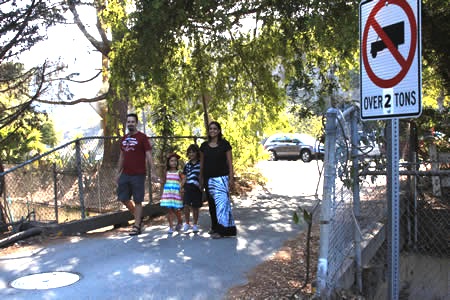
Trash day proves much more of a chore than it used to be for Deborah Young and her neighbors in an unusual Laguna Canyon enclave. For the last six months, Young has dragged her garbage bins about half a block out to Laguna Canyon Road for the weekly garbage pickup. Engineers declared the bridge unsafe for trucks exceeding two tons, effectively barring garbage truck and fire engines from the principal entry to the north end of what is officially known as Sara Thurston Park.
For now, cars can still come and go. But residents in the neighborhood sandwiched between Milligan and Woodland Drives fear it’s only a matter of time before the decrepit bridge, deemed “in urgent need of repair” in a staff report presented to the City Council last week, no longer supports them either.
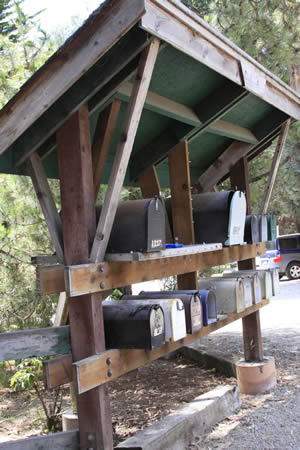
“If we lose that bridge, we lose the lifeline to our community,” said 27-year resident Peter Morrisson, who appealed to the Council last week for aid.
As it is, fire trucks can now only reach Milligan Drive by crossing the private property of a Canyon Acres Drive resident who has allowed temporary access.
“This is the road I take in and out to take the kids to school, to soccer practice, to the grocery store,” said nine-year resident Peri Doshi-O’Neill.
The decades-old bridge crosses a county flood channel at the entrance of a tiny private street, 400-foot Milligan Drive. It provides vehicular access for about 36 residents in a dozen or so homes buffered from the canyon road by a communal dirt parking area and backyard-sized park. Though only a mile from downtown and the beach, the historic neighborhood feels like a rural sanctuary. Built without curbs and gutters or standard setbacks, homes are closely clustered along gravel footpaths. Visitors to the pedestrian lanes, such as the aptly named Fairywood Walk, are struck by the bucolic setting, with tree-filtered light dappling eclectic homes looking as though conjured by a wizard to create a backdrop for nursery rhymes.
Residents are still hoping for a happy ending, though they recently discovered bridge maintenance is at least partly their responsibility. And the estimated $300,000 sum to replace the span proved prohibitive when a few residents tried to launch a neighborhood initiative to fund the project.
Staff proposed a city-initiated assessment district as a solution, but that begged the question of whether the residents could afford their share if apportioned on a per parcel basis.
As the city owns seven parcels that comprise the parking area and park, as well as a sewer system that requires bridge
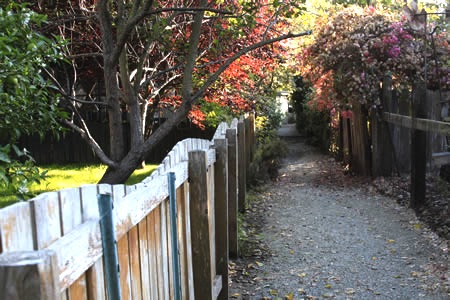
access, there is some justification for the city to contribute to the project, Public Works Director Steve May told the council.
The bridge rests on now eroded concrete abutments atop the channel. County staff disclaimed any ownership of or maintenance responsibility for the wooden structure, even though they replaced it in 1957 when they constructed the channel, May said. Nor will Caltrans accept any responsibility for the bridge, though it sits within the Caltrans right-of-way for Laguna Canyon Road.
Nearly 30 years ago, the city and the county agreed to use community development block grant funds to make Milligan Drive a public roadway and to widen and improve it, including replacing the bridge, but the project cited in the Sara Thurston Park Specific Plan never came to fruition.
Still, none of the homeowner’s property records, either titles, deeds or sale documents, contain any mention of the bridge, said Morrisson. Until the bridge’s dilapidated state prompted investigation, residents had no clear understanding that its repair might fall to them. “It never crossed our minds that the bridge was private,” he said, even though they had all chipped in to maintain and resurface the private road over the years.
Only when city staff completed their research did residents realize the extent of their responsibility. “It’s a complicated thing,” Morrisson said.
In fact, the neighborhood has long defied traditional community standards, since characteristics that bestow it with a unique charm also make it a poor fit to comply with current municipal codes.
Sara Thurston Park began as a campsite, when no structures were envisioned. Instead of roadways, a series of six-foot lanes connect the small lots. By the 1930s and ‘40s summer and vacation homes began to spring up, followed by permanent residences, a transition the specific plan attributes to “the urbanization of the Laguna Beach area.” The unintended use posed some infrastructure problems, such as septic tanks inadequate for year-long use, a problem since remedied. But, as the plan states, “the pedestrian orientation and rural setting…probably would not have occurred if Thurston Park had been originally planned for permanent residential use.”
And those very attributes continue to give it the verdant fairyland quality so prized by its current residents.
“It’s just a special little retreat for us,” said Young, who with her late husband, artist Robert Young, built a magical home quite equal to its surroundings. “We like that it’s kind of secret and private,” she said. What’s more there’s a strong community spirit. Residents pitched in to refurbish the passive park, bringing mulch and wood chips, creating what Young called a “vital” gathering place since most lots are small and without yards. Now maintained by the city, the park serves as a venue for residents’ birthday parties and an annual Cinqo de Mayo celebration.
“The neighborhood is very, very tight,” agreed Morrisson, a trait he said, “has a lot to do with the fact that there are no roads.”
Dashi-O’Neill, too, feels that “the walking paths really create a sense of community.” She and her husband Craig O’Neill bought their home in 2004, when there were few other children and before their son and daughter, now 7 and 5, were born. But now there are more young families whose children play together in the park. “We feel really grateful to be able to live here,” said Doshi-O’Neill. “Everyone has each other’s back; we watch each other’s kids.”
The residents are desperate to preserve the bridge that links their idyllic neighborhood to the rest of the city, but question the burden of a $300,000 assessment.
“We need your help,” Ken Dalena told the Council last week. He said the residents aren’t looking for a handout, just some assistance for “people working who need to get across that bridge.”
The City Council seemed to agree. “I think we ought to advance the project $30,000 right now,” said Mayor Pro Tem Elizabeth Pearson. “Just advance it for now and get a plan.” The rest of the council agreed.
The first step is getting an engineer’s assessment of the project’s scope and cost, said May. Then the Council will have to consider how to divvy up those costs.
For now, residents are grateful that city officials seem willing to find a solution. In the meantime, Young said she has been investigating bridges herself, looking for solutions that might be less costly.


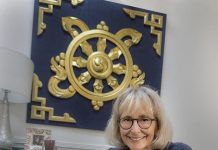
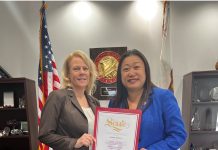

[…] Some property owners questioned costly proposed repairs to a Milligan Drive bridge that other residents say is needed to ensure emergency access to a tiny and historic Laguna Canyon enclave. […]
[…] project will cost $425, 193. The city will contribute 37 percent because it owns seven parcels. For residents, assessments will range from $1,600 to […]